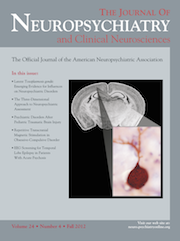The “Closing-In” Phenomenon in Parkinson’s Disease Dementia and Lewy-Body Dementia
Letter to the Editor: The closing-in phenomenon, that is, the tendency to close in on a model while performing a constructive task, has been reported in Alzheimer’s disease (AD),1 frontotemporal dementia,2 and vascular dementia.3 Recent studies suggested that closing-in probably reflects a compensatory strategy to overcome basic visuospatial dysfunctions involved in the preliminary visuo-perceptual analysis and/or in the on-line maintenance of the visual representation of the model while performing a copying/drawing task.4 Although visuospatial impairment is also a common cognitive feature in synucleinopathies, such as Parkinson’s disease dementia (PDD) and Lewy-body dementia (LBD),5 closing-in has never been reported in these disorders. We report on four cases of synucleinopathies (three PDD and one DLB) in which we detected closing-in phenomena.
Case 1: “GM” is a 76-year-old, right-handed man. He received a diagnosis of Parkinson’s disease (PD) when he was 67 years old. When he was 74, he began to show mild cognitive difficulties (MMSE: 25/30), especially related to executive functions (Frontal Assessment Battery [FAB] score: 12/18). Two years later, he developed a clear dementia associated with PD (levodopa daily dose: 940 mg/day; UPDRS-II/III: 15/32; Hoehn & Yahr [H&Y] rating, 3). GM then showed impaired cognitive status (MMSE: 20/30), with severe impairments of executive functions (FAB score: 8/18) and visuospatial functions (Benton’s Judgment of Line Orientation [JOL] score: 12/30; Raven's Colored Progressive Matrices [CPM], 16/36). During constructional praxis tasks, he showed closing-in of the “overlap” subtype.3
Case 2: “DM” is a 71-year-old, right-handed man. He received a diagnosis of PD when he was 64 years old. When he was 69, he began to show mild cognitive difficulties (MMSE: 23/30), especially related to executive functions (FAB: 11/18) and visuospatial functions (Benton’s JOL: 18/30; Raven's CPM: 19/36). One year later, he developed visual hallucinations, and, after 2 years, he developed PDD (levodopa daily dose: 675 mg/day; UPDRS-II/III: 19/24; H&Y: 3). DM presented a worsened cognitive status (MMSE: 16/30) and a severe and worsened impairment of executive (FAB: 7/18) and visuospatial functions (Benton’s JOL: 13/30; Raven's CPM: 15/36). During constructional praxis tasks, he showed closing-in of the “adherent” subtype.3
Case 3: “QB” is a 79-year-old, right-handed man. He received a diagnosis of PD when he was 74 years old. He shows cognitive difficulties (MMSE: 21/30), especially related to executive (FAB: 8/18) and visuospatial functions (Benton’s JOL: 18/30), that led to the diagnosis of PDD (levodopa daily dose: 750 mg/day; UPDRS-II/III: 10/31; H&Y: 2.5). During constructional praxis tasks, he showed closing-in of the “overlap” subtype.3
Case 4: “SD” is an 81-year-old, right-handed, married man. Six months ago, he began to show fluctuating mild cognitive impairment and visual hallucinations; then a mild parkinsonism also appeared. The DaT-SCAN- SPECT revealed bilateral putaminal degeneration. His global cognitive status was impaired (MMSE: 22/30), especially related to executive (FAB: 8/18) and visuospatial functions (Benton’s JOL: 15/30; Raven's CPM: 19/36). He received a diagnosis of LBD. During constructional praxis tasks, he showed closing-in of the “adherent” subtype.3
These cases show that the closing-in phenomenon may be present also in synucleinopathies associated with dementia, as PDD and DLB, in which visuospatial impairment is often a cognitive hallmark.
1 : A large-scale retrospective study of closing-in behavior in Alzheimer’s disease. J Int Neuropsychol Soc 2009; 15:787–792Crossref, Medline, Google Scholar
2 : Closing-in behaviour in fronto-temporal dementia. J Neurol 2009; 256:1004–1006Crossref, Medline, Google Scholar
3 : “Closing-in” phenomenon in Alzheimer’s disease and subcortical vascular dementia. BMC Neurol 2004; 4:3Crossref, Medline, Google Scholar
4 : The closing-in phenomenon in the drawing performance of Alzheimer’s disease patients: a compensation account. Cortex 2010; 46:1031–1036Crossref, Medline, Google Scholar
5 : Visual hallucinations and altered visual information-processing in Parkinson disease and dementia with Lewy bodies. Mov Disord 2010; 25:167–171Crossref, Medline, Google Scholar



